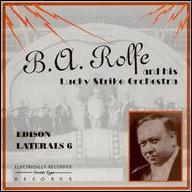B.A. Rolfe
from Brasher Falls, NY
October 24, 1879 - April 23, 1956 (age 76)
Biography
Louis Armstrong made a point of singling out this all but forgotten brass virtuoso as the man who inspired him to develop the ability to produce very high notes on the trumpet. Who was B.A. Rolfe? Born in Brasher Falls, New York in October of 1879, as a child he played piccolo and cornet in his father's band, which performed mostly at skating rinks. When the family ensemble went on tour, he appeared before the public at concerts all over Europe billed as "The Boy Trumpet Wonder." He graduated directly from high-school into full-time employment with the Sparks Circus where, among other tasks, he performed as a musical clown. When he was about 18, he quit the circus to lead and play solo cornet with the Majestic Theater Orchestra in Utica, New York. He also took on a position at the Utica Conservatory of Music, where he presided over the brass instrument department. The year 1904 marked the beginning of Rolfe's attempts to succeed as a vaudeville producer and bandleader. Meeting with only marginal success, he soon reverted to the trusty brass band formula and hit the road once again, appearing in front of concert bands throughout North America. In 1909 he took one of these ensembles to Europe. Rolfe's next stab at success involved the motion picture industry. Between the years 1914 and 1918, he produced more than 100 silent films. Even though some of these flicks featured legendary magician and master of escape Harry Houdini, financial difficulties eventually caused Rolfe Photoplays to careen headlong into bankruptcy, only to be absorbed by Columbia Pictures. Picking himself up and dusting himself off, Rolfe started all over again in 1920 as a performing soloist, music instructor and vaudeville producer. He worked with Vincent Lopez in 1924 and '25. Then, inspired by Paul Whiteman, Rolfe assembled his own dance orchestra in 1926. During the spring of that year, he began appearing with this band at a Chinese restaurant and cabaret on Broadway called the Palais D'Or. Broadcast live over the airwaves seven times each week, B.A.Rolfe and His Palais D'Or Orchestra began to enjoy some measure of popularity. Settling in, they continued to serenade the patrons over plates of chop suey as the band's engagement was expanded from four weeks to four years. In a newspaper article describing the orchestra in action, there is a description of an instrument apparently invented by Rolfe called the "Rolfaphone, which may be best described as a mammoth bass xylophone." Apparently, this contraption was used in performances at the restaurant. Its existence certainly puts Rolfe in the same league with peculiar percussionist and bandleader Harry A. Yerkes. Around this time, Rolfe became an exclusive Edison recording artist. Between the years 1926 and 1929, 135 of is Dance Orchestra sides were issued under his name, in addition to eight sides by his Concert Orchestra, and four solo trumpet recordings. A handful of the Dance sides actually possess some of the qualities of real jazz, such as Buffalo Rhythm backed with a version of Fletcher Henderson's Rocky Mountain Blues. Also noteworthy are Louisiana Bo Bo and Phil Napoleon's No Parking. Eventually, Rolfe secured the highest salary ever paid by Edison to any recording artist. In September of 1928, Rolfe vaulted up to an even more complex level of bandleading on #the Lucky Strike Dance Hour, heard three hours each week over nationwide network radio. The Lucky Strike Dance Orchestra had 55 pieces. Among the ranks of its personnel could be found ex- Whiteman bandmembers Milton Rettenberg, Ross Gorman, and Tommy Dorsey. Gladys Rice and Elizabeth Lennox sang while Rolfe himself spoke as calm, collected master of ceremonies. In time he became established as a "radio personality." The orchestra's style, however, with its rhythms reminiscent of the circus and the ever-conspicuous presence of the xylophone (or maybe it was that Rolfaphone!) began to seem ossified even by 1930. Rolfe was dropped by Lucky Strike in October, 1931. Updating and "normalizing" his orchestra's sound, he was able to continue working in radio for a few more years. His sponsor in 1932 was Ivory Soap. In 1933 and '34 it was Hudson Automobiles. Periodically, for about ten years beginning in 1934, Rolfe's sponsor was Ripley's Believe It or Not. Appropriately enough, he performed in 1935 on a show called +Circus Nights in Silvertown. That same year he was heard as host of an NBC wake-up show. Rolfe was last heard leading an all-female orchestra playing patriotic melodies during 1942. He passed away in Walpole, Massachusetts on April 23rd, 1956. ~ arwulf arwulf, Rovi
Top Tracks
Albums
Videos
Close

















